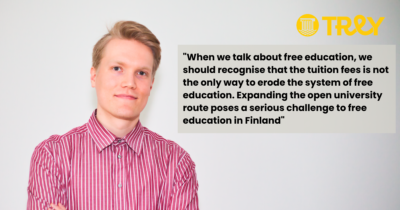What are we talking about when we discuss free education? The first thing that usually comes to my mind is tuition fees, which probably happens to anyone who is actively following the broader societal discussion about educational affairs. However, this time my purpose is not to take a stance on the tuition fees but to draw our attention to concerning developments that are easily forgotten when we engage in a debate on the tuition fees.
Let us take Jyväskylä University School of Business and Economics as an example. Recently the number of students who can enter the school via so-called open university route was increased to 70 students. The number might seem insignificant, but it constitutes 45 percent of all the students who are taken into the study programme. This is a clear step towards developing an alternative route to the university, which is not free. To enter the School of Business and Economics the student must complete 45 study credits in the open university and the students pays for the studies. The price tag for this study path is more than 650 euros.
Another similar example is the Bachelor’s Degree on Public Law offered by University of Vaasa and University of Eastern Finland. The degree is nearly completely studied in the open university – only the Bachelor’s thesis may be done for free.
Both of these examples sound dubious for the advocates of free education. In practice, the student needs to bear an economic burden before they even begin in an actual study programme. Young adults who are just becoming independent belong to the citizens with the lowest income level – extra money is not available in their daily lives.

The open university route is more and more offered to the applicants who do not have a previous higher education degree. The alternative route means that we have a system where the student pays for the studies and avoids the normal selection procedures. In addition the student is left without a student community, student benefits and many university services. We students cannot accept this.
The Ministry of Education and Culture is funding a project called Alternative Path to University (TRY). The aim of the TRY project is to develop and establish different paths to higher education in addition to entrance exams and the matriculation examination. The project should also examine how to develop the open university route in a way that it does not create inequalities between the higher education students.
The open university route does not need to cost or be a burden for students. Free selection courses that require a moderate amount of work are a welcome development. For example, in Tampere a selection course for social sciences has been piloted this year.
The open university route has been very popular recently and there seems to be a will to expand it. However, the current discussion focuses mainly on the student selections while the impact on free education in the Finnish higher education system has been ignored.
So, when we talk about free education, we should recognise that the tuition fees is not the only way to erode the system of free education. Expanding the open university route poses a serious challenge to free education in Finland, which is an alarming trend in the educational policy.
We would like to see that the open university route is used to increase opportunities for free education among those who do not have previous higher education studies. In this way we would also enhance access to higher education for young adults with low income.
Ville Jäppinen – Member of TREY’s Executive Board